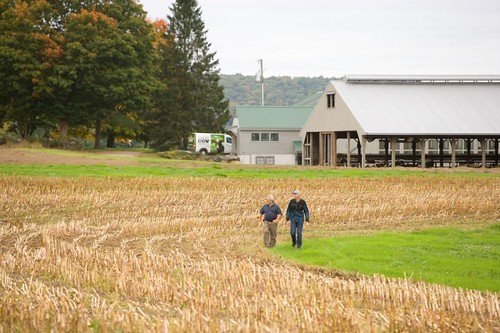
Producers survey a field in the Northeast. Photo Credit: Scott Bauer (2007)
The Northeast Regional Climate Hub covers Connecticut, Delaware, Maryland, Maine, Massachusetts, New Hampshire, New Jersey, New York, Pennsylvania, Rhode Island, Vermont, West Virginia, and the District of Columbia. The Northern Forests Climate Sub Hub shares this footprint and represents people working and living in the forests of the Northeast.
About 21 percent of land in these 12 states is farmland (6 percent of national total), and 62 percent is classified as timberland (total land area covered by trees is somewhat larger). The northeastern United States is home to about 175,000 farms that collectively produce agricultural commodities worth more than $21 billion per year. The most important commodities in the Northeast are dairy production and poultry, and about half of the field crops (including pasture) grown in the Northeast are for animal feed. Horticulture is a relatively large portion of total plant production in the Northeast, as are perennial fruits such as apples, pears, blueberries, and cranberries. Farms in the Northeast are on average smaller than in many other parts of the country, and a greater percentage of these are operated by women than in the rest of the United States. Organic production is relatively greater than in most other regions.
More intense and higher rainfall totals increase the burden that agriculture and forest producers face in being able to conduct timely operations. The Northeast Regional Climate Hub is working across a range of crops, forests, and livestock production systems to assemble the available information into tools and practices that can increase the resilience of these systems to climate change. Practices that improve soil health and protect soils from erosion are of particular importance because healthy soils are a key to productivity and resilience.
This vulnerability assessment reviews present knowledge of agricultural and forest susceptibility to climate variability in the Northeast and will serve as a guide to focus future adaptation work. We thank our Land Grant university partners for their leading role in this assessment, especially Daniel Tobin of Pennsylvania State University. We look forward to continuing to work with our partners to identify and encourage practical and cost-effective methods for increasing farm and forest resilience to climate variability and change. The Northeast Regional Climate Hub is working hard to assemble information that serves the needs of producers and increases the value of our research information in educational and outreach efforts.
David Hollinger, Northeast Hub Lead
Howard Skinner, Northeast Hub Co-Lead
Christopher Swanston, Northern Forests Sub Hub Lead
Each USDA Regional Climate Hub will be publishing a Vulnerability Assessment in 2015—stay tuned for your region in the coming months! http://climatehubs.oce.usda.gov/content/regional-vulnerability-assessments.
No comments:
Post a Comment
Note: Only a member of this blog may post a comment.